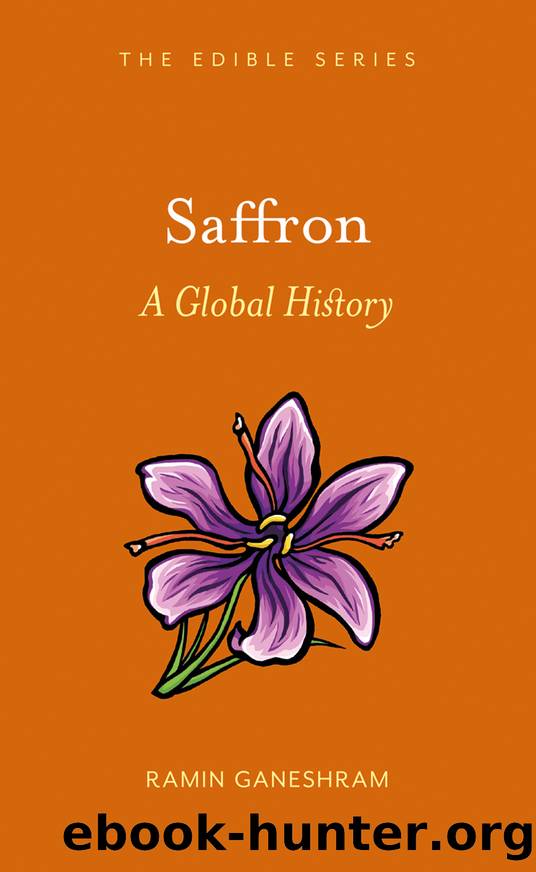Saffron by Ramin Ganeshram

Author:Ramin Ganeshram
Language: eng
Format: epub
Publisher: Reaktion Books
The worldâs primary saffron-producing nations and regions.
Saffron pickers work against the clock, since the saffron-picking window is a small one: the flower only blooms in the autumn, and the best time to harvest â right after the morning dew has evaporated â limits opportunity further.
Another issue with saffron growing is its areas of cultivation. Historically, few climates have presented the perfect conditions to grow saffron, although stalwart devotees have tried to grow it in virtually every corner of the world â with more success in some areas than others. In modern times, climate change is potentially redrawing the map of saffron-growing zones, often to the detriment of regions historically known for growing saffron and where saffron culture is an integral part of local heritage.
Pampore in the Indian region of Kashmir is often considered to be the producer of the worldâs best-quality saffron. The Food and Agriculture Organization of the United Nations has named this region of saffron cultivation, and regions in Iran and Afghanistan, to be Globally Important Agricultural Heritage Systems. The GIAHS designation serves in much the same way as AOC in France (Appellation dâorigine contrôlée, or label of controlled origin) or DOC (Denominazione di origine protetta, or label of protected origin) in Italy do â to verify the authenticity and purity of the food product in question. Another aspect of the designation is that it recognizes how integral the farming systems or crops in the GIAHS area are to the fabric of local society in a cultural sense as well.
However, excessive drought and political conflict is having an impact on the Kashmiri harvest. In the 1990s, a single Kashmiri farmer could produce up to 400 kg (around 880 lb) of saffron per year. Production dropped to half that amount a decade ago. In 2018 farmers were reporting crop yields that amounted to less than 10 kg (22 lb) for the entire year. Add to that the fact that Kashmir is the worldâs most militarized zone â a Muslim territory in India that, though granted autonomy over seventy years ago, is under continual occupation, with a conflict death toll numbering in the tens of thousands â and saffron growers find it increasingly hard to engage in their trade. Saffron is high on the list of what modern culinary scholars call âconflict foodâ: traditional food customs that are being irrevocably altered by social, political or military conflict in a given region.
Download
This site does not store any files on its server. We only index and link to content provided by other sites. Please contact the content providers to delete copyright contents if any and email us, we'll remove relevant links or contents immediately.
World's Best Whiskies by Dominic Roskrow(42257)
Whiskies (Collins Gem) by dominic roskrow(42206)
101 Whiskies to Try Before You Die by Ian Buxton(42174)
Whiskies Galore by Ian Buxton(40326)
The Fast Metabolism Diet Cookbook by Haylie Pomroy(20486)
Chic & Unique Celebration Cakes by Zoe Clark(19354)
Craft Beer for the Homebrewer by Michael Agnew(17445)
The Bone Broth Miracle: How an Ancient Remedy Can Improve Health, Fight Aging, and Boost Beauty by Ariane Resnick(16131)
Tools of Titans by Timothy Ferriss(6944)
How to Be a Bawse: A Guide to Conquering Life by Lilly Singh(6692)
Cravings: Recipes for All the Food You Want to Eat by Chrissy Teigen & Adeena Sussman(6331)
The Institute by Stephen King(6250)
A Court of Wings and Ruin by Sarah J. Maas(6070)
The Last Wish (The Witcher Book 1) by Andrzej Sapkowski(4657)
Wiseguy by Nicholas Pileggi(4585)
The Fat Loss Plan by Joe Wicks(4236)
Hunger by Roxane Gay(4216)
Spare by Prince Harry The Duke of Sussex(4195)
Room 212 by Kate Stewart(4102)
